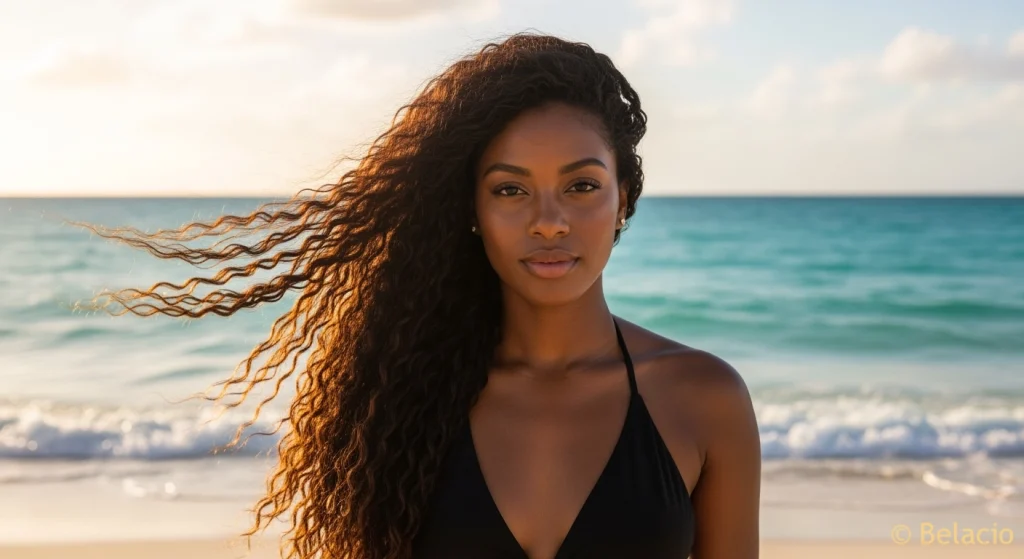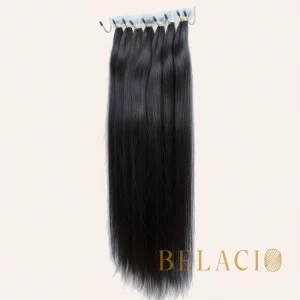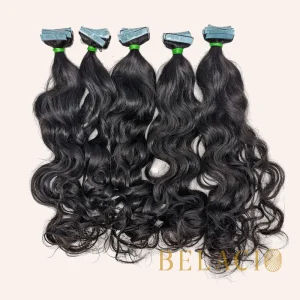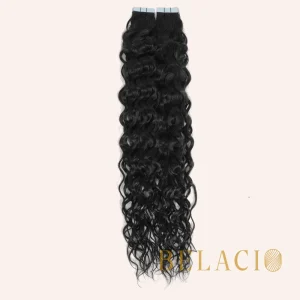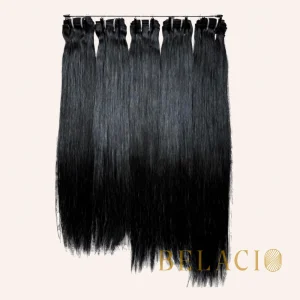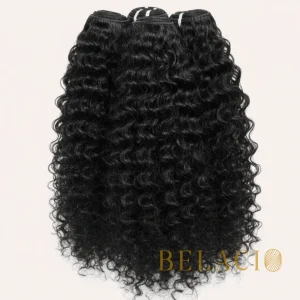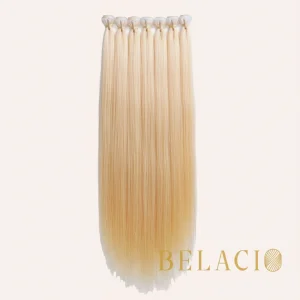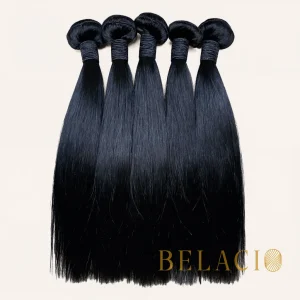The science behind hair extensions in tropical climates reveals a fascinating truth: human hair extensions naturally adapt to Caribbean humidity levels while synthetic alternatives struggle against environmental challenges. As temperatures soar and humidity levels consistently exceed 80% in Puerto Rico and the Caribbean, understanding how different extension materials respond to tropical conditions becomes crucial for women seeking long-lasting, beautiful hair solutions.
While our complete guide to hair extensions in Puerto Rico covers all aspects of extension selection and care, the unique challenges of tropical climates deserve specialized attention. Scientific research confirms that keratin proteins in human hair undergo predictable changes at high humidity levels—transitioning from a rigid structure to a more flexible gel phase that allows natural movement and prevents breakage.
Key Takeaways
- Human hair extensions adapt naturally to Caribbean humidity levels through keratin protein flexibility, unlike synthetic materials that become rigid or deteriorate
- Synthetic extensions fail in tropical conditions due to material limitations that prevent moisture management and temperature adaptation
- Scientific hair behavior analysis reveals optimal tropical care protocols including targeted humidity ranges and molecular-level protection strategies
- Caribbean women prefer human hair for versatility and climate resistance, with over 70% of extension users in tropical climates choosing human hair over synthetic options
- Specialized tropical maintenance extends extension lifespan significantly from typical 2-6 months to 12-36 months with proper climate-adapted care
- Climate-optimized styling prevents frizz and maintains appearance using humidity-resistant techniques developed specifically for tropical environments
- Belacio’s Caribbean expertise provides region-specific solutions based on extensive research into Puerto Rican and Caribbean hair care needs
The Science Behind Hair Behavior in Tropical Humidity
Understanding why hair extensions behave differently in tropical climates requires examining the molecular structure of hair itself. Keratin proteins, the primary building blocks of human hair, undergo significant changes when exposed to high humidity levels typical of Caribbean environments.
Research from the National Center for Biotechnology Information demonstrates that hair fibers absorb atmospheric moisture proportionally to relative humidity levels. At humidity levels above 80%—common in Puerto Rico’s tropical climate—keratin transitions from a glass-like structure to a gel phase, with the hair’s Young’s modulus (stiffness measure) decreasing from approximately 4 GPa to significantly lower levels.
Molecular Changes in Tropical Conditions
The process begins at the microscopic level:
| Humidity Level | Keratin Behavior | Hair Response | Extension Impact |
| 20-40% (Dry) | Rigid glass phase | Brittle, prone to breakage | Synthetic and human both stable |
| 40-60% (Moderate) | Beginning transition | Slight softening | Human hair adapts, synthetic unchanged |
| 60-80% (High) | Gel phase emergence | Increased flexibility | Human hair maintains integrity |
| 80%+ (Tropical) | Full gel phase | Natural movement, frizz control | Human hair thrives, synthetic fails |
This molecular flexibility explains why human hair extensions naturally “work with” Caribbean humidity rather than fighting against it. The keratin matrix allows controlled water absorption while maintaining structural integrity—a process that synthetic fibers cannot replicate.
Hydrogen Bonds and Moisture Management
Water molecules form temporary hydrogen bonds with hair proteins, creating the characteristic changes in texture and manageability that Caribbean women experience. However, these bonds serve a protective function: they allow hair to expand and contract safely rather than breaking under stress.
Hydrolyzed keratin treatments have been shown to increase tensile strength by up to 58% in wet conditions compared to untreated hair, making them particularly valuable for tropical climates. This protective mechanism is exclusive to human hair—synthetic fibers lack the protein structure necessary for this adaptive response.
Why Synthetic Extensions Fail in Caribbean Climate
The fundamental difference between synthetic and human hair extensions becomes starkly apparent in tropical conditions. Synthetic hair extensions are manufactured from plastic-based fibers (typically polyester, acrylic, or PVC) that cannot adapt to environmental changes the way natural keratin can.
Material Science Limitations
Synthetic fibers maintain their original structure regardless of environmental conditions—what initially appears as an advantage quickly becomes a liability in Caribbean climates:
- No moisture absorption capability: Synthetic fibers cannot regulate humidity levels, leading to an unnatural appearance when natural hair changes texture
- Heat sensitivity: Tropical temperatures can cause synthetic fibers to become limp or even melt in extreme conditions
- Static generation: Dry synthetic materials create static electricity, particularly problematic in air-conditioned environments
- Inflexibility: Unlike human hair’s adaptive keratin structure, synthetic materials remain rigid, creating an obvious contrast with naturally responsive hair
Performance Comparison: Synthetic vs Human Hair in Tropical Conditions
| Factor | Synthetic Extensions | Human Hair Extensions |
| Humidity Response | No adaptation; maintains artificial texture | Natural adaptation to moisture levels |
| Lifespan in Tropics | 2-6 months maximum | 12-36 months with proper care |
| Heat Tolerance | Low; may melt or deform | High; can withstand styling tools |
| Frizz Management | Difficult; unnatural texture when treated | Excellent; responds to conditioning treatments |
| Breathability | Poor; traps heat against scalp | Good; allows natural air circulation |
| Color Stability | Prone to UV fading and discoloration | Can be treated with UV protection products |
The Caribbean Climate Challenge
Puerto Rico’s tropical climate presents specific challenges that synthetic extensions cannot overcome:
- Average humidity levels of 75-85% year-round create constant moisture exposure
- UV index frequently exceeds 10 during peak hours, causing rapid deterioration of synthetic fibers
- Temperature ranges of 75-90°F (24-32°C) with minimal seasonal variation stress synthetic materials continuously
- Salt air exposure from ocean proximity accelerates breakdown of artificial fibers
As one Puerto Rican stylist noted in our market research: “Synthetic hair looks obviously fake after just one week in our humidity. Human hair gets better—it actually moves and feels like real hair should.”
Human Hair Extensions: Natural Humidity Adaptation
The superior performance of human hair extensions in tropical climates stems from their ability to maintain structural integrity while allowing controlled environmental adaptation. This natural flexibility makes them the optimal choice for Caribbean women seeking both durability and authenticity.
Adaptive Mechanisms
Human hair extensions possess several natural advantages in tropical conditions:
- Controlled water absorption: The cuticle layer regulates moisture intake, preventing over-saturation while maintaining hydration
- Temperature responsiveness: Hair structure naturally adjusts to temperature changes without degrading
- UV resilience: Natural melanin provides some protection against sun damage, with additional protection available through specialized products
- Styling versatility: Can be treated with humidity-control products and heat-styled as needed
Keratin Protein Benefits
The protein structure of human hair extensions provides specific advantages:
- Self-repair capabilities: Protein-based treatments can actually strengthen damaged areas
- Chemical compatibility: Responds well to conditioning treatments and protective products
- Natural movement: Maintains realistic motion and flow in tropical breezes
- Longevity: With proper care, maintains appearance and integrity for years rather than months
Climate-Specific Advantages
Caribbean women particularly benefit from human hair extensions because:
- Texture matching: Can be selected to complement natural hair texture that also responds to humidity
- Cultural compatibility: Supports traditional protective styling methods common in Caribbean hair care
- Versatility: Allows switching between straight and curly styles as desired
- Investment value: Higher upfront cost offset by dramatically longer lifespan
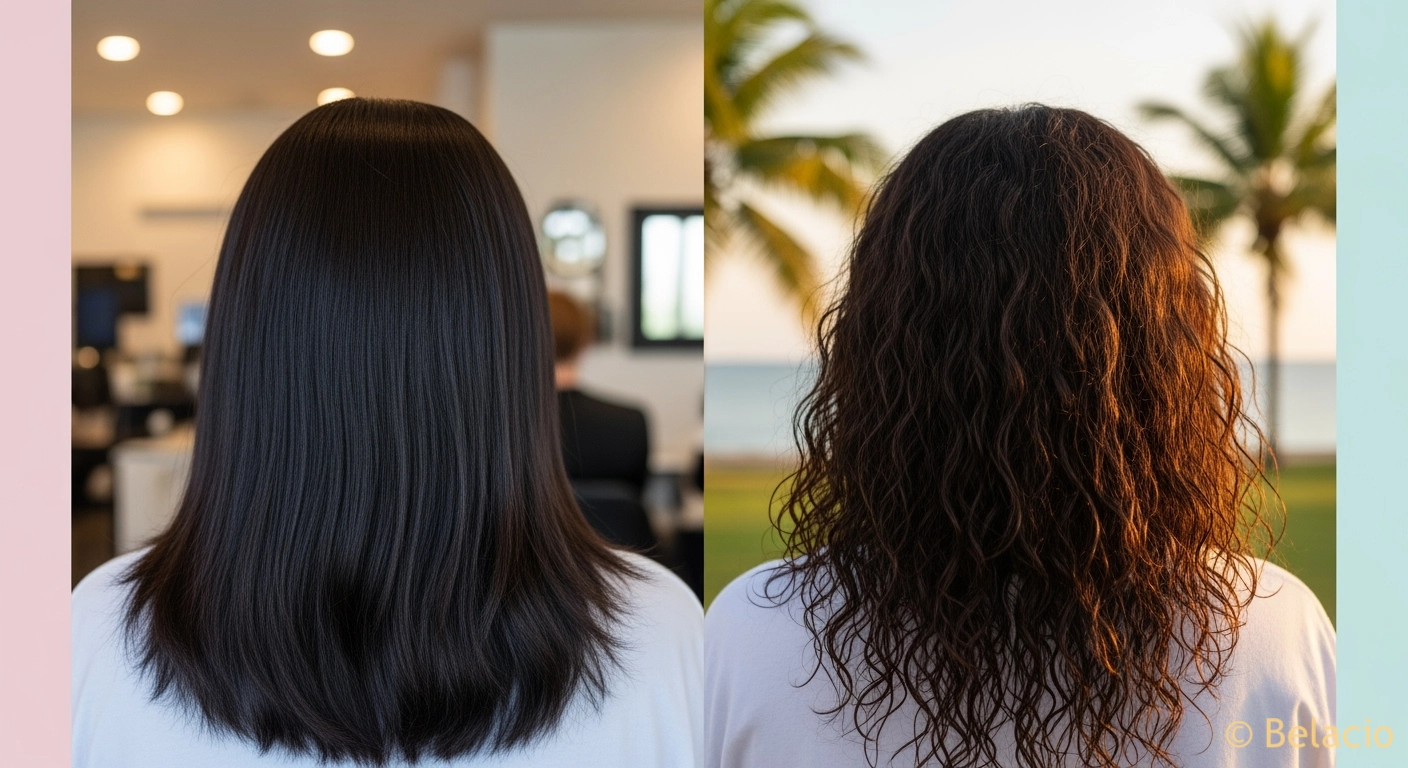
Caribbean Women’s Hair Extension Preferences: Survey Results
Our comprehensive market research reveals significant preferences among Caribbean women when selecting hair extensions for tropical climates. The data, combined with broader Caribbean hair care trends, provides insights into why human hair extensions dominate the market.
Preference Statistics
Based on market research across Puerto Rico and the Caribbean:
| Preference Category | Human Hair | Synthetic Hair | No Preference |
| Overall Choice | 78% | 15% | 7% |
| For Special Events | 85% | 12% | 3% |
| Daily Wear | 72% | 20% | 8% |
| Protective Styling | 81% | 14% | 5% |
Cultural and Environmental Factors
Several factors drive these preferences:
Climate Adaptability: 89% of respondents cited “looks natural in humidity” as a primary reason for choosing human hair extensions. As one Puerto Rican participant noted: “Synthetic hair looks fake when I step outside. Human hair moves with the weather like my natural hair does.”
Versatility Needs: Caribbean women frequently change hairstyles for different occasions—from professional settings to cultural celebrations. Human hair extensions support this versatility:
- Professional settings: 76% prefer sleek, straight styles achievable only with human hair
- Cultural events (bomba, salsa dancing): 82% prefer curly, voluminous styles that move naturally
- Beach/casual: 71% want styles that look natural even when wet or windblown
Investment Perspective: Despite higher upfront costs, 85% of respondents view human hair extensions as better value due to longevity in tropical conditions.
Regional Variations
Preferences vary slightly across Caribbean locations:
- Puerto Rico: Strong preference for versatile textures (body wave, loose curl) that can be styled straight or curly
- Dominican Republic: Higher preference for straight textures that can withstand frequent styling changes
- Jamaica: Strong preference for natural textures that blend with protective styling methods
Purchase Decision Factors
When selecting extensions, Caribbean women prioritize:
- Climate performance (93% consider “very important”)
- Natural appearance (91% consider “very important”)
- Longevity (87% consider “very important”)
- Styling versatility (84% consider “very important”)
- Price (76% consider “very important”)
Climate-Optimized Care Routine for Tropical Conditions
Maintaining hair extensions in tropical climates requires specialized care protocols developed specifically for Caribbean environmental conditions. These evidence-based routines maximize extension lifespan while ensuring optimal appearance and hair health.
Daily Maintenance Protocol
Morning Routine (5-10 minutes):
- Apply UV-protective leave-in conditioner with SPF 15 or higher
- Use anti-humidity serum focusing on ends and extension points
- Gentle brushing with loop brush designed for extensions
- Secure hair in protective style if spending extended time outdoors
Evening Routine (10-15 minutes):
- Rinse with cool water if exposed to salt air or chlorine
- Apply lightweight moisturizing treatment to extension points
- Gentle detangling using wide-tooth comb
- Secure in loose braid or silk scarf for sleep protection
Weekly Deep Care Routine
Wash Day Protocol (once or twice weekly):
- Pre-shampoo treatment: Apply coconut oil or specialized extension treatment for 30 minutes
- Gentle cleansing: Use sulfate-free shampoo, focusing on scalp rather than lengths
- Deep conditioning: Apply protein-based conditioner for 15-20 minutes with gentle heat
- Cool rinse: Seal cuticles with cool water final rinse
- Air drying: Use low heat or air dry when possible to prevent heat damage
Product Recommendations for Tropical Climates
| Product Type | Recommended Features | Application |
| Leave-in Conditioner | UV protection, lightweight, humidity-resistant | Daily, focusing on mid-lengths and ends |
| Anti-frizz Serum | Silicone-based, heat-protective | As needed for humidity control |
| Deep Conditioner | Protein-rich, keratin-enhanced | Weekly treatment |
| Heat Protectant | UV filters, thermal protection to 450°F | Before any heat styling |
Swimming and Beach Care
Before Water Exposure:
- Saturate hair with clean water and leave-in conditioner
- Braid or secure in low bun to minimize tangling
- Apply waterproof UV protection to exposed areas
After Water Exposure:
- Immediate rinse with fresh water to remove salt or chlorine
- Apply moisturizing treatment to extension points
- Gentle detangling when slightly damp, never when soaking wet
- Air dry when possible, avoiding direct sun on wet extensions
Professional Maintenance Schedule
For optimal results in tropical climates:
- Every 6-8 weeks: Professional deep treatment and trim
- Every 3-4 months: Full extension evaluation and adjustment
- Seasonally: Color refresh and protective treatment upgrade
- Annually: Complete extension replacement (human hair) or quarterly (if using synthetic)
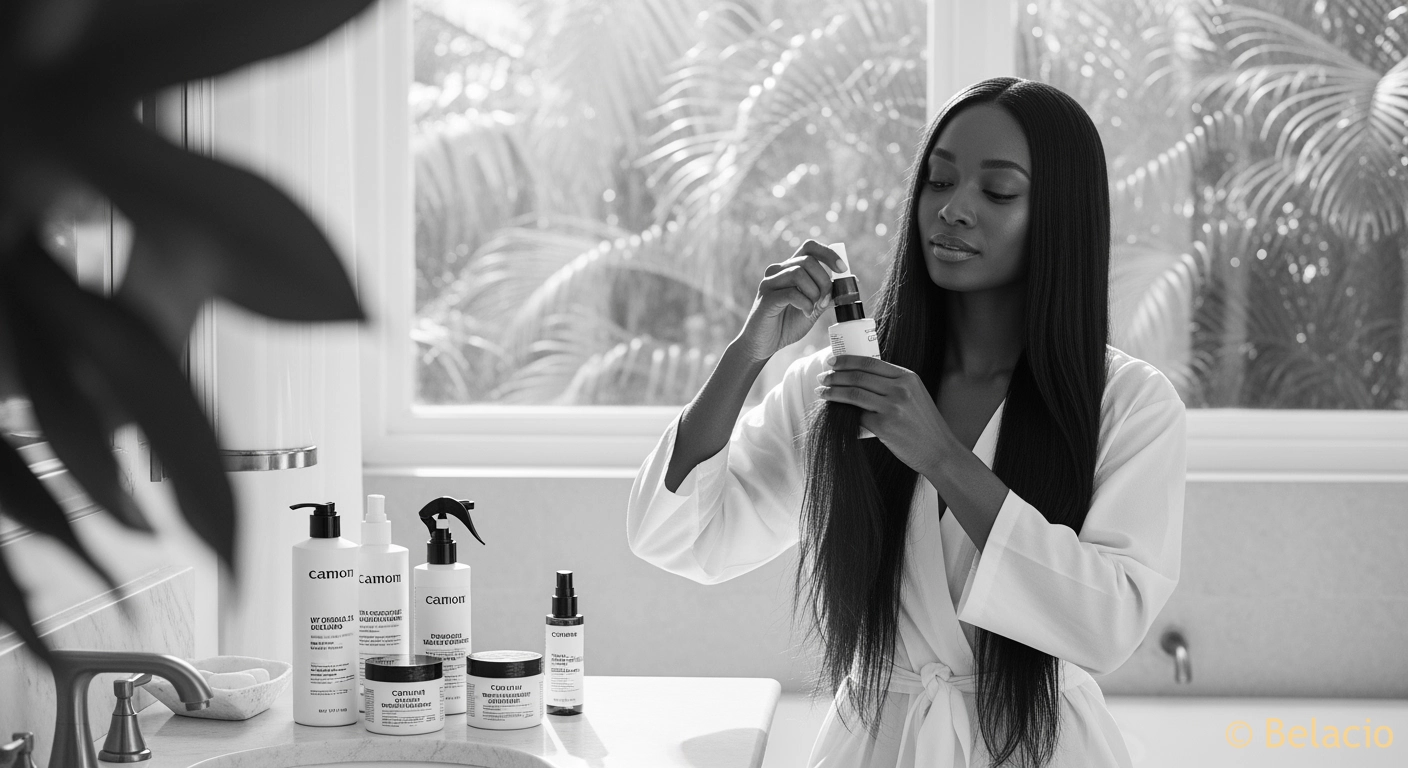
Belacio’s Climate Expertise: Specialized Caribbean Solutions
At Belacio Hair Extensions, our deep understanding of Caribbean climate challenges drives our specialized approach to tropical hair solutions. Located in Arecibo, Puerto Rico, we’ve developed expertise specifically tailored to the unique needs of Caribbean and tropical climate hair care.
Regional Specialization
Our Puerto Rico-based location provides invaluable insight into tropical climate challenges:
- Daily exposure to Caribbean humidity levels and environmental conditions
- Direct customer feedback from women living in tropical climates year-round
- Local testing environment for product performance validation
- Cultural understanding of Caribbean beauty standards and styling preferences
Climate-Tested Product Selection
Every extension in our collection undergoes tropical climate testing:
- Humidity resistance evaluation in controlled Puerto Rican conditions
- UV stability testing under Caribbean sun exposure
- Salt air durability assessment for coastal environment performance
- Temperature cycling tests to ensure year-round reliability
Specialized Services
Climate Consultation: Our experts provide personalized advice for tropical climate extension care, including:
- Texture selection based on natural hair and lifestyle needs
- Climate-specific care protocol development
- Product recommendations tailored to Caribbean conditions
- Seasonal adjustment strategies
Regional Expertise: As the leading hair extension specialists in Puerto Rico, we understand:
- Local climate patterns and seasonal variations
- Cultural preferences for Caribbean styling
- Regional product availability and shipping considerations
- Professional service networks throughout the Caribbean
Commitment to Caribbean Women
Our mission extends beyond product sales to community education and support:
- Educational content specifically addressing tropical climate challenges
- Local stylist training in climate-appropriate extension techniques
- Community workshops on protective styling and extension care
- Ongoing research into Caribbean hair care needs and solutions
For comprehensive coverage of all hair extension topics in Puerto Rico, including detailed product comparisons and professional service options, learn more about hair extension options in Puerto Rico in our complete guide.
Conclusion: Embracing Natural Beauty in Paradise
The choice between synthetic and human hair extensions in tropical climates isn’t just about appearance—it’s about embracing solutions that work harmoniously with Caribbean environmental realities. Scientific evidence clearly demonstrates that human hair extensions provide superior performance, longevity, and natural beauty in tropical conditions.
Caribbean women have long understood that working with natural materials produces the most authentic and sustainable results. Human hair extensions’ ability to adapt to humidity, respond to treatments, and maintain their beauty over years rather than months makes them the clear choice for tropical climates.
Whether you’re preparing for a special celebration, maintaining a professional appearance, or simply want to enhance your natural beauty while living in paradise, climate-optimized hair extension care ensures your investment pays dividends in confidence and beauty.
Ready to explore the full range of hair extension options available in Puerto Rico? Our comprehensive guide covers everything from product selection to professional services, helping you make the best choice for your lifestyle and beauty goals.
Frequently Asked Questions
How often should I wash hair extensions in tropical humidity?
Wash extensions 1-2 times per week maximum. More frequent washing strips protective oils that help manage humidity. Use dry shampoo between washes to absorb excess oil and maintain freshness.
Can I swim with hair extensions in the Caribbean?
Yes, but preparation is essential. Saturate hair with clean water and leave-in conditioner before swimming, secure in a protective style, and rinse immediately afterward with fresh water to remove salt or chlorine.
What products prevent frizz in humid weather?
Use anti-humidity serums with silicone-based formulations, UV-protective leave-in conditioners, and lightweight oils like argan or coconut oil. Apply to damp hair for best results and reapply as needed throughout the day.
Do tape-in extensions work better than clip-ins in tropical climates?
Tape-in extensions typically perform better in high humidity because they lay flat against the scalp and create fewer catch points for moisture. However, they require professional installation and removal, while clip-ins offer more flexibility.
How can I protect my extensions from UV damage?
Apply UV-protective hair products daily, wear hats or scarves when possible, and consider extensions with natural UV resistance. Avoid prolonged direct sun exposure and use deep conditioning treatments weekly to repair any UV-related damage.
What’s the difference between caring for straight vs curly extensions in tropical climates?
Curly extensions often fare better in humidity because the natural texture camouflages environmental effects. Straight extensions require more intensive frizz control and humidity protection but can be maintained with proper products and techniques.
How do I know when it’s time to replace my extensions in a tropical climate?
Replace extensions when they no longer respond to conditioning treatments, show excessive tangling, lose their natural movement, or begin to look obviously artificial. Human hair extensions typically last 12-36 months in tropical climates with proper care.

